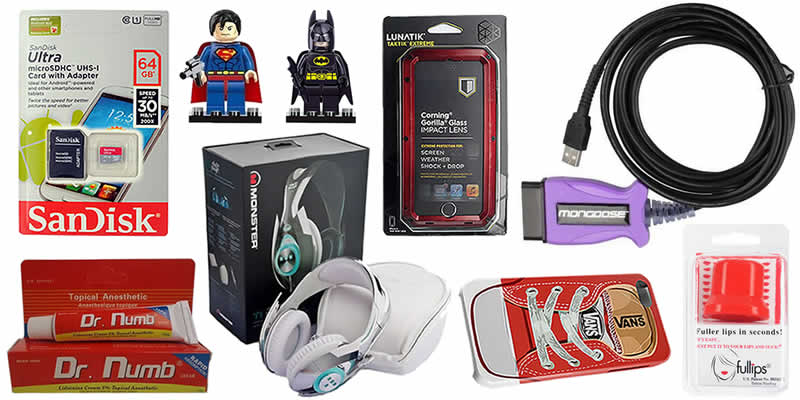Online Gift Buying Risky for Holiday Shoppers
Deceptive Amazon and eBay counterfeit products easily fool gift givers.
December 06, 2016, Los Angeles, CA – The joy of the holiday season brings a new twist to gift giving; you may end up with a counterfeit. With over 90% of holiday shoppers planning to go online to buy gifts at bargain prices this holiday season, holiday vendors and the web are a haven for scam artists selling counterfeit merchandise.
"Consider the economic and personal risk of buying counterfeit goods, and be very skeptical of any online product, unless purchased from authorized retailers" says The Counterfeit Report®, a counterfeit awareness and consumer advocate. Consumers are easily deceived and unknowingly purchase counterfeit products from eBay (EBAY), Amazon (AMZN), Alibaba (BABA) and others. These counterfeit gift purchases often go undetected until after the holidays when the product fails, is returned for warranty, or causes an injury. Some are deadly.
Both eBay and Amazon have channeled their business model into online “Marketplace” retail outlets which allow un-vetted global sellers to peddle hugely profitable counterfeit goods to unsuspecting consumers. The e-commerce websites are proving to be the ideal platform to distribute the counterfeit goods.
The problem isn’t just the well-known fakes; watches, shoes and handbags, but a vast counterfeit universe of auto parts, cosmetics, drugs, electronics, sporting goods, toys, and much, much more. Consumers can see the authentic and deceptive counterfeits on The Counterfeit Report.
Counterfeit products are a serious problem for e-commerce websites and consumers. With many retailers matching website prices, consumers are better served and protected purchasing from authorized retailers.
eBay
eBay is migrating from the auction house of garage sale items to concentrating on Marketplace sales of new items (80%) at a fixed price (86%) from global sellers. That move is drawing an avalanche of counterfeits from both US and global un-vetted sellers.
For example, The Counterfeit Report identified over 2.5 million counterfeit items on eBay and reported over 1.8 million to eBay for listing removal. Over 560,000 were already reported sold to eBay consumers. The sellers usually remain and often relist the fakes, and the deceived eBay buyers are never told by eBay they received a fake and may be entitled to a refund. Unfortunately, many counterfeit items are listed and sold before eBay acts to remove them.
Remarkably, buyers can’t even turn to eBay's feedback as an indication of seller credibility – eBay admits it may be altered, and counterfeit listings that have been removed are not reflected in eBay seller feedback.
Amazon
Many Amazon consumers do not recognize that Amazon listings present three distinct global product outlet channels, including its 2-million Marketplace account holders who can ship counterfeit products, which are never inspected by Amazon, from all over the world.
Apple recently claimed that 90% of Apple products it purchased from Amazon Direct were fake. Birkenstock, a popular sandal maker, pulled the plug on Amazon sales citing an uncontrollable counterfeit problem. Smaller manufacturers complain that their business is being destroyed by the e-commerce sites counterfeit sales.
The Counterfeit Report conducted dozens of name-brand test purchases from Amazon Fulfillment and Amazon Marketplace sellers, but never received an authentic item. Counterfeits were also purchased from Amazon Direct and Amazon Warehouse Deals.
Infringement notices were submitted to Amazon for 11,713 counterfeit items offered on the website. Despite Amazon’s claim that the listings were removed, some listings still remained, or the sellers were allowed to relist the inarguably fake items. Amazon allows multiple sellers to list against “permanent catalog page” images (stock photos) making identification of counterfeit products difficult.
Could you identify these actual counterfeits purchased on Amazon or eBay? Most don't even exist in the manufacturer's authentic product line.

(Clockwise from left – Photo: The Counterfeit Report®)
E-Commerce giants, Amazon, eBay and Alibaba are no strangers to allegations of selling counterfeit goods. The e-commerce giants face a credibility crisis fueled by their failure to crack down on counterfeit goods and making it easy for the world’s largest criminal enterprise to peddle $1.7 trillion in counterfeit goods to unsuspecting consumers. Social media sites Facebook®, Twitter® and Instagram® have also become popular counterfeit outlets, while Walmart and Best Buy were also caught offering counterfeits.
Counterfeiting supports organized crime, terrorists and criminals who avoid taxes, destroy an estimated 750,000 US jobs, and cost US businesses over $250 Billion annually. Illegal counterfeiting activity is profitable, difficult to track and widely unpunished.
 |